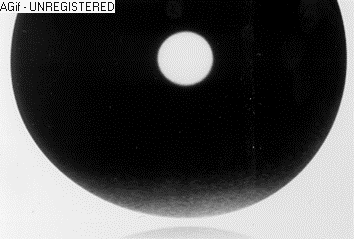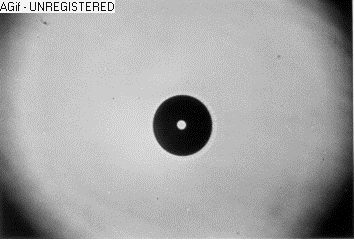My Projects
Topic: Multiphase Flow
Title: Spreading and Splashing of Drops


The images show the impingement of drops on a glass plate.
The drops are visualized by shadow imaging with homogeneous background lighting.
The picture sequence on the left shows drops by a side view –
the picture sequence on the right give a perpendicular view through the glass plate.
At the end, the complete course of actions is visualized by multi-exposure imaging.
What one doesn’t see:
The experimental setup is based on hydrophobic surfaces. The experiments are performed at night to avoid vibrations. The drop diameter is varied between 2 and 4 millimeters. The impact velocity is varied by the height of fall between 2 and 8 m/s. Drops of such size and speed can be assumed as spherical. By mixtures of purified water and glycerol, the viscosity of the liquid is varied between 1 and 20 mPas – while the surface tension stays about constant.
The background lighting is achieved by an enlarged projection from the tip of an optical fiber supplied by a stroboscopic light emitting diode LED. The pictures are taken by charged coupled devices CCD in a camera. The trajectories of the moving fronts are obtained by calibration of the LED flashes and the CCD pixel resolution. The evaluation is supported by special image processing software.
What’s behind it:
The incoming drop liquid spreads radially around the point of impact in a thin layer or lamella. The top or apex to the drop is hardly retarded, which permits to calculate the volume flux of the lamella by the plug flow of the drop. However, in the moment when the speed of expansion falls below the velocity of surface waves on the lamella, the spreading comes abruptly to an end, as visible on the images by the undulate patterns propagating from the rim of the lamella to its center. After about 1 ms, the kinetic energy is mostly conversed to potential energy of the stretched surface – and dissipation, for sure. Afterwards it needs about a second to shrink the wetted surface to a new equilibrium of a so-called sessile drop, where the proper load of the liquid matches the surface and interface tensions to air and substrate, respectively.
During the forced spreading another pattern occurs on the circumference of the lamella. As visible by the starlike appearance of the multi-exposure image, the pattern occurs already at the beginning and remains azimuthally constant. A Fourier analysis of the pattern reveals that it has a distinct periodicity. And the variation of kinematic and material parameters gives a correlation of that periodicity with the Weber number, which means that an effect of inertia and surface tension can be assumed. Presumably, the strong deflection of the drop flow at impact causes radially spiraling vortices, aka Görtler vortices, which form a bulge at the advancing front line.
A splashing to subsequent secondary drops occurs, when the lamella takes off from the glass plate and bursts. This can happen in several consecutive cascades. The take off occurs earlier when the viscosity of the liquid is higher due to increased shear stress. Therefore, the amount of splashed liquid is higher, although the secondary drops are larger, then. Thus, increased viscosity provides more spray with less refinement.
What you can obtain from it:
The knowledge about the hydraulic changes of a drop flow – and the different phases of energy conversion – allows a better understanding and optimization of wetting as well as its simulation. The phenomena of splashing are of practical relevance for processes such as erosion, combustion and spray painting.
My related publications:
Etalement et éclatement de gouttes, (i.e. Spreading and Splashing of Drops) Ph.D. thesis, University Pierre et Marie Curie UPMC, Sorbonne universities of Paris 6 (1990)
Splashing of Drops, Archives of Mechanics – Archiwum Mechaniki Stosowanej, No. 4-5/90 (1990)
Inertial Spreading of Drops, Fundamentals of Fluid Transport in Porous Media, Arles, France, (1990)
The Influence of Viscosity on Splashing of Drops, Proceedings ‘1st European Fluid Mechanics Conference’, Cambridge UK (1991)